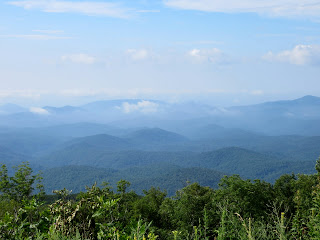 We back-tracked from Rocky Knob campground on the Blue Ridge Parkway to Mabry's Mill. Mabry built and lived here between about 1900 and 1930. He built a very clever mill, particularly since the water volume wasn't that great. He began with a grist mill (where I bought some buckwheat flour and some corn grits). When the water volume was sufficient he ran the saw mill at left.
We back-tracked from Rocky Knob campground on the Blue Ridge Parkway to Mabry's Mill. Mabry built and lived here between about 1900 and 1930. He built a very clever mill, particularly since the water volume wasn't that great. He began with a grist mill (where I bought some buckwheat flour and some corn grits). When the water volume was sufficient he ran the saw mill at left. He also ran a woodworking shop. Here are all the wheels that had belts connected to them to run the woodworking tools.
He also ran a woodworking shop. Here are all the wheels that had belts connected to them to run the woodworking tools. The tools included this double jig saw which he used to make wooden wheels. The jig and the holes allowed him to set the size of the wheels. He also had a clever gadget that made tongues and grooves on flooring.
The tools included this double jig saw which he used to make wooden wheels. The jig and the holes allowed him to set the size of the wheels. He also had a clever gadget that made tongues and grooves on flooring. 
The mill is probably the most-photographed image on the Blue Ridge Parkway. There was a ranger who was building a chair from wormy chestnut wood rescued from the split rail fences along the Parkway. They were built in the 1930's due to a kill off of the trees and now have deteriorated further. He rescues the wood and makes handmade chairs. He had a horse that held the wood while he used a hand tool to make the dowels. He had a lovely example with a caned seat from hickory bark.
This shows the gear on the water wheel.


Mabry collected water from two streams. This is the flue from the stream that is presently powering the mill.
 Mabry got ill and couldn't continue to keep up the mill, though his wife continued to work there. This shows the peg construction used on the flue.
Mabry got ill and couldn't continue to keep up the mill, though his wife continued to work there. This shows the peg construction used on the flue.We continued along the Parkway until we came to
 Trail's Cabin which had "a right fine view." The cabin was common for this area.
Trail's Cabin which had "a right fine view." The cabin was common for this area. Towards the end of the Parkway we came to the remnants of a logging railroad built in the 1920's.
Towards the end of the Parkway we came to the remnants of a logging railroad built in the 1920's.
 We continued on to Skyline Drive, 105 miles long at 35 mph through Virginia and drove to a campground. The views were similar to those along the Blue Ridge Parkway, but we love the pace and the views and the cheap camping.
We continued on to Skyline Drive, 105 miles long at 35 mph through Virginia and drove to a campground. The views were similar to those along the Blue Ridge Parkway, but we love the pace and the views and the cheap camping.We arrived in Tunkhannock and our job for this summer. Bob and I will be converting all this 2" styrofoam into roof insulation. We began on Wednesday tearing down a wall in the area that is going to be the bathroom on the second floor and removing all the tongue-in-groove paneling, sistering out the rafters to 6" (which involves ripping 1/4" strips and nailing them to the existing rafters) and adding vapor barrier. Then we will add three sheets of styrofoam (with lots of cutting and fitting) and a fourth piece that covers it all.



Here is Bob cutting out the octagon for a window at each end of the second floor.
Thursday night there were tornado warnings and the wind blew harder than Markus had ever seen it. It rained hard and we lost electricity. Thank heavens for the gas generator which powered the fridge and a few lights and the gas stove in Snoopy which provided dinner. The sunset was stunning.
In contrast, this isn't the sunset. This is a natural gas well that is burning off the methane. This process lasts six weeks and apparently sounds like a jet taking off. There is a new pipeline through our area, but the desire to put a pipeline through our property seems to be on hold. The drilling by Chesapeake is slowing way down due to the company's financial problems.
































